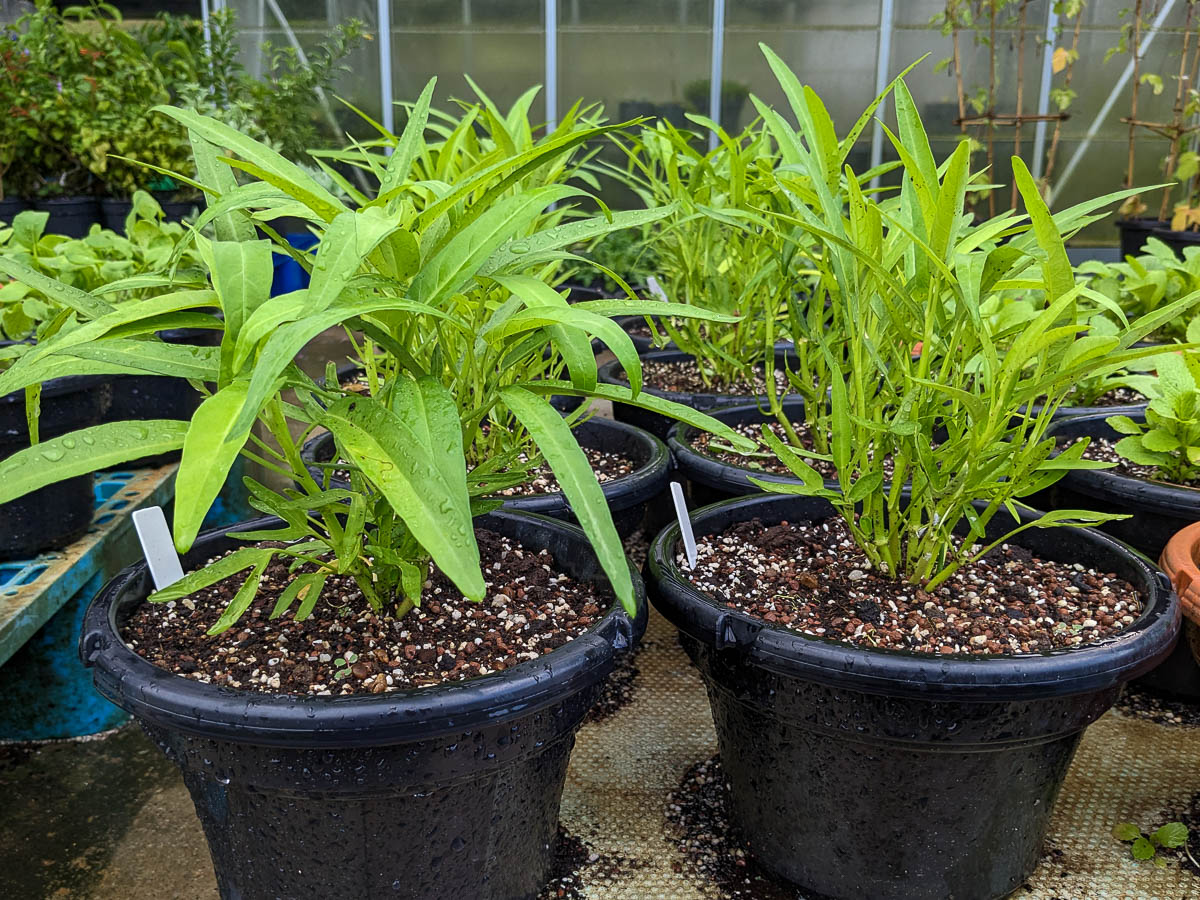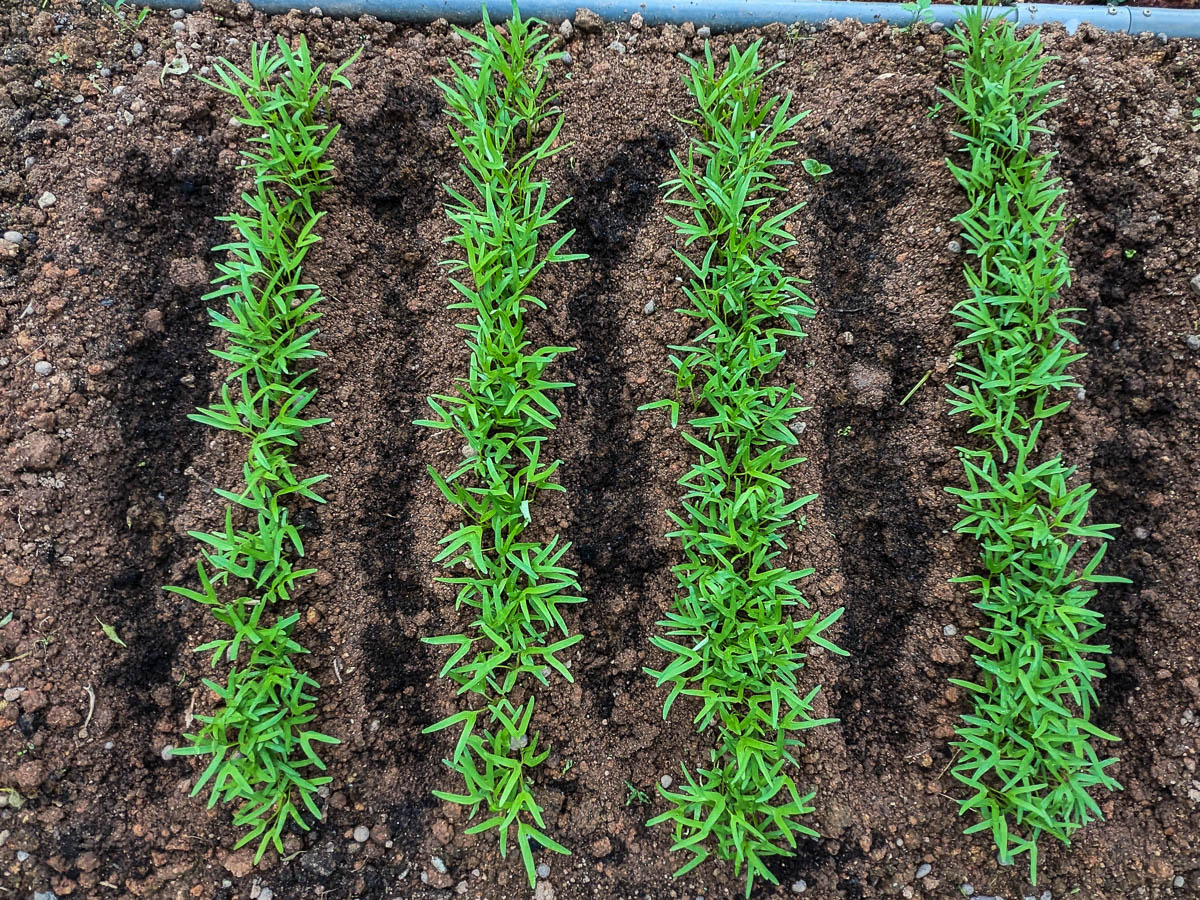Kang Kong
Kang Kong (Ipomoea aquatica)
Other common names: Kangkong, Swamp Cabbage, Swamp Morning-glory, Water Morning Glory, Water Spinach, Chinese Water-spinach, Water Bindweed, Water Convolvulus, 蕹菜, 空心菜
.jpg)
Kang Kong is an iconic staple in a variety of Southeast Asian cuisines, and a common sight in local edible gardens around the region. It is a perennial crop that grows as a vine, making it a useful permanent addition to any edible garden. Young leaves and stems are eaten raw, stir fried or blanched. The sprouts can also be eaten as microgreens!
This fast-growing perennial crop can be used as an edible groundcover or a living mulch to suppress weeds and protect soil from the sun and rain.
Because the stem of this plant is hollow, it can float on water and can be found growing naturally along the banks of water bodies like rivers and ponds, forming a thick mat of vegetation.
This vine is from the Ipomoea or Morning Glory family, and in the same genus as Sweet Potato.
Sun and soil needs:

This hardy vine thrives in full sun gardens and can grows best with 4-8 hours of direct sunlight. It can also grow in more than 6 hours of indirect sunlight, but at a slower pace.
Plants do best in pots with loamy soil at least 10cm deep, or in true ground. This plant is highly tolerant of clayey and waterlogged soils and can be used in gardens that are watered frequently, that are prone to flooding, in areas exposed to large amounts of rain, and along the edges of ponds.
As a fast-growing vine, this plant is traditionally left to sprawl on large patches of soil, but it can be also grown up a trellis. Regular pruning will encourage additional growth and improve air circulation.
Sowing seeds:

Seeds can be sown directly into pots or the ground around 10cm apart. Seeds can also be scattered on rows spaced 10cm apart, with the seedlings thinned to individual plants spaced 10cm apart two weeks after germination. Lightly water the soil until damp, once a day. Seeds should sprout within a week.
The seedlings may be eaten by snails or birds. Protect your young plants with a DIY cloche or netting.
Growing:
Kang Kong grows rapidly when fed with high nitrogen fertilisers. Plants can be fertilised once every two weeks after germination for a fuller crop.
Because the vines will grow on top of each other, it is a good practice to prune regularly to improve ventilation and allow light to reach more of the plant.
This vine grows large very rapidly and can climb up to 3m if a tall enough surface is available. Prune it back to manageable heights and densities to make harvesting and maintenance easier.
Harvesting:
Plants can be harvested for leaves and stems, with younger leaves being the most tender. Most gardeners will begin harvesting from their Kang Kong plant around 3 weeks after sowing.
Kang Kong is typically harvested multiple times by harvesting the younger leaves and stems as per the cut-and-come-again method.
Harvest cycle:
| Growing period | Sowing to germination | Germination to transplanting | Transplanting to first harvest | Total sowing to first harvest |
|---|---|---|---|---|
| Approximate time | A week or less | A week or less | 2 to 3 weeks | 3 weeks to a month |
Check out our sowing and harvest planner to schedule your growing!
Propagation:
.jpg)
This vine can be grown via seeds or by stem cuttings rooted in water or soil.
Common problems & solutions:
This plant is relatively resistant to pests and disease if kept healthy.
Young plants have soft stems and can be completely eaten by slugs and snails. Grow seedlings till they are at least 10cm tall before planting them in true ground, or use DIY cloches or netting to protect young plants.
Etiolation is characterised by plants growing long and skinny, with weak stems and small leaves. The plants may also sometimes look yellowish. Plants etiolate when they do not get enough sunlight, which results in slow growth and untidy forms. To prevent this, grow plants in environments with enough light for them and make sure that each plant has enough space to prevent overcrowding.
Wilting leaves during hot weather is a sign of heat stress. Increase the number of times the plant is watered daily, and apply mulch at the base to prevent water loss.

